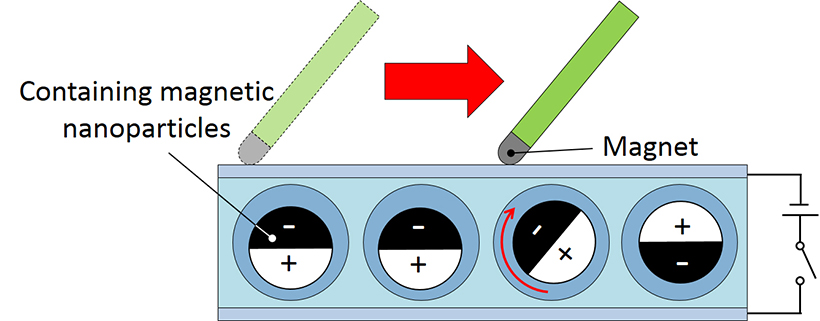A simple structure of bi-colored balls made of tough, inexpensive materials is well suited for large handwriting-enabled e-paper displays
From the Journal: Journal of Applied Physics
Researchers from the University of Tokyo have revamped an old e-paper concept to make an inexpensive handwriting-enabled e-paper well suited to large displays like whiteboards. They describe the e-paper in the Journal of Applied Physics, from AIP Publishing.
Traditional ink and paper is convenient for both reading and writing. In e-paper development the writing feature has generally lagged behind. Handwriting-enabled displays mainly show up in the inexpensive, but feature-limited realm of children’s toys, and in the high-end realm of touch-screen e-readers and smart pens.
A team of Japanese researchers has now taken an e-paper technology originally developed in the 1970s and updated it to make a tough and inexpensive display that could be used like a whiteboard when a large writing space is required.
The display is made from bicolored microparticles about 0.1 millimeters in diameter. One hemisphere of each particle is black and carries a negative charge, while the other is white and carries a positive charge. The particles are sandwiched between two electrodes. By switching the direction of the voltage across the electrodes the background display can be switched between black and white.
Such “twisting ball” displays are not new, but the researchers were the first to integrate a magnetic field control component with the original electric control. In addition to carrying a negative charge, the black side of the microparticles also contains magnetic nanoparticles that make it possible to write on the screen.
A magnet pulled across the surface of the white display attracts the black side and the balls flip to face the magnet. In this way images and lines can be drawn on the display. A magnet with about the strength of a refrigerator magnet will work for this task.

Applying a voltage will immediately erase the drawings. In the absence of a voltage or magnetic field, the image is maintained without using any energy.
“Toughness, cost, size and color are the advantages of our e-paper display,” said Yusuke Komazaki, a researcher in the Graduate School of Frontier Sciences at the University of Tokyo and lead author on the paper. The display is made from materials like acrylic polymer, silicone elastomer, and silicone oil that are relatively inexpensive and hold up well under UV light. Because of the e-paper’s simple structure, large displays can be easily fabricated, Komazaki said. In addition, the researchers could easily change the color combinations by substituting different microparticle pigments, he said.

The researchers believe low-cost, lightweight, and energy-saving electronic whiteboards are a suitable application for the new e-paper. “Conventional electronic whiteboards are equipped with large LCDs or projectors and are very expensive, less visible in bright light conditions, heavy, and energy consuming,” Komazaki said, so the new displays could have many competitive advantages.
“If we fabricate super-large displays, it might even be possible to replace traditional blackboards in classrooms,” Komazaki said.
The team is working to improve the contrast of the display, which they believe can be achieved by increasing the amount of black and white pigment in the microparticles.
Eventually, the researchers believe their work could contribute to a world that is much less dependent on traditional paper.
“Writing and drawing is an indispensable feature of paper, so we believe that our handwriting-enabled e-paper is closer to real paper than conventional e-papers,” said Komazaki. “Someday, handwriting-enabled e-paper may replace real paper.”
###
For More Information:
Jason Socrates Bardi
+1 240-535-4954
jbardi@aip.org
@jasonbardi
Article Title
Electrically and magnetically dual-driven Janus particles for handwriting-enabled electronic paper
Authors
Y. Komazaki, H. Hirama and T. Torii.
Author Affiliations
University of Tokyo
